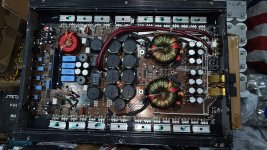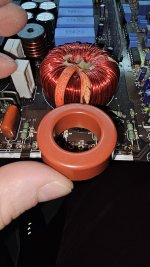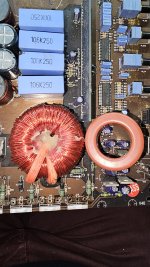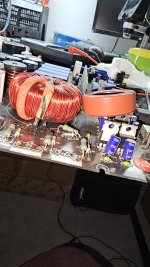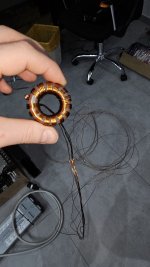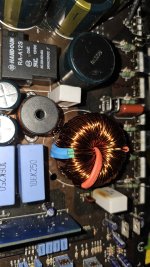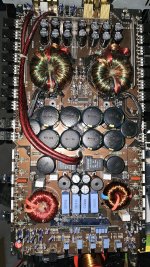Hello lads, I own this amplifier, it was left to me by a customer who no longer wanted to repair it.
Unfortunately, the situation is this:
one of the two output inductors was taken from someone else.
Now I can disassemble the other inductor and measure it, so I could obtain the value in uH and make another one like it, but in your opinion, what type of core should I get?
Thanks in advance.
Mario
Unfortunately, the situation is this:
one of the two output inductors was taken from someone else.
Now I can disassemble the other inductor and measure it, so I could obtain the value in uH and make another one like it, but in your opinion, what type of core should I get?
Thanks in advance.
Mario
Attachments
I'd suggest wrapping it with 10 turns (you can leave the other windings in place. That will allow you to calculate the AL.
You then need to select a material with that AL and other properties you want. Molypermalloy will have the least loss but will be expensive. Others will have varying loss and cost less. More loss will mean more heating but some heating isn't bad.
You then need to select a material with that AL and other properties you want. Molypermalloy will have the least loss but will be expensive. Others will have varying loss and cost less. More loss will mean more heating but some heating isn't bad.
Hi Ultra, in these 3 photos below, you can see a T157-2 core compared to the original inductor.T157-2 should be the correct one. But i doubt that Koreans use this type.
Even taking into account that there is no wire wound, it seems to me that the original core is larger (I don't know precisely by how much) than the T157-2.
It could be that there are more layers on the original core, but I have to check.
I could unroll the original inductor, counting the turns and then rewind it with the same turns.
I have a question:
Suppose the original core IS NOT T157-2, if I use a T157-2 to wind the other inductor, will I have to respect the same number of turns?
Regardless of this, after getting two inductors of the same uH value, if the cores are different, can they work together on the same amplifier?
Perry, what do you think?
Attachments
The overall value is likely most important (using a suitable core). A core with higher AL will produce more inductance with fewer turns. Fewer turns will make the core run hotter and may push it to saturation (if the number of turns is significantly less, again, depends on the material).
I'd try to get the AL and the diameter then decide on a material.
The 152 of the part number is the diameter. The -2 is the core material.
This page doesn't use the same material designations but will give you an idea of the various properties.
https://www.mag-inc.com/design/design-guides/inductor-cores-material-and-shape-choices
This page has a calculator for AL with input for inductance and number of turns.
https://powermagnetics.co.uk/calculator/
I'd try to get the AL and the diameter then decide on a material.
The 152 of the part number is the diameter. The -2 is the core material.
This page doesn't use the same material designations but will give you an idea of the various properties.
https://www.mag-inc.com/design/design-guides/inductor-cores-material-and-shape-choices
This page has a calculator for AL with input for inductance and number of turns.
https://powermagnetics.co.uk/calculator/
Finally i ve used t157-2 core with 79 turns of 4 x 1mm enamelled cable getting exactly the same values (80uH & 0.74ohm) of the original one.
The amp work and both the coils stay cool at the same temp.....
Seems to be working but now is time for a stress test...
What do you think about?
The amp work and both the coils stay cool at the same temp.....
Seems to be working but now is time for a stress test...
What do you think about?
